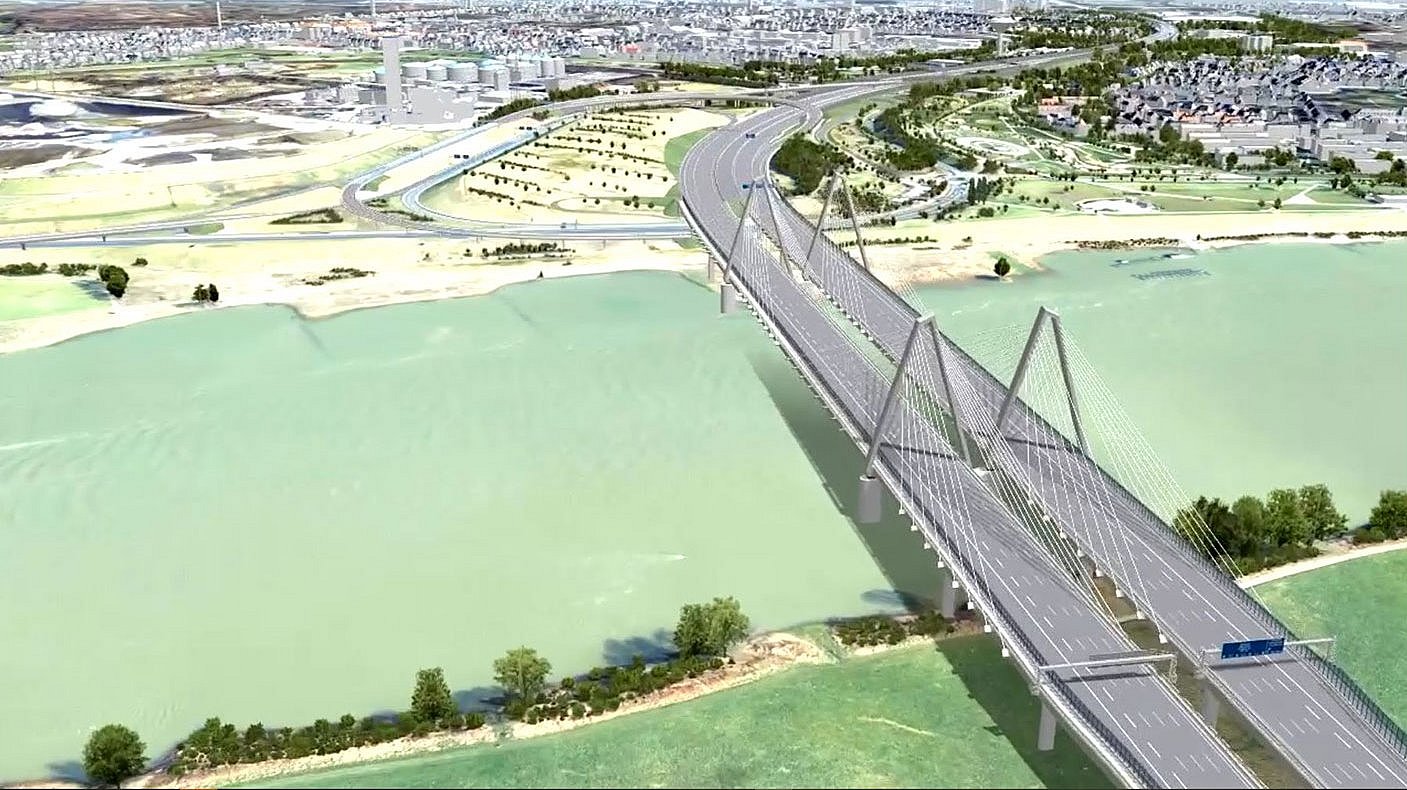Lifeline surgery
Experts attested to the "critical structural condition" of the old A1 bridge between Leverkusen and Cologne back in 2012. Together with partners, we completed the first section of the new Rhine bridge between the beginning of 2021 and the end of 2023.
Our Team
Jan Felgendreher
The boss
Jan Felgendreher
The boss
Head of the bridge construction department, project manager for the first bridge section
“Every leader should have children. They will demonstrate your limits.” Jan Felgendreher has two sons who went to school in England, because until 2012 he worked eight years there for HOCHTIEF. The 53-year-old managed the further construction of the first section of the bridge and pushed it forward quickly. Because as a Cologne resident, he has been stuck in traffic jams here often enough. Hesitating, having reservations, hedging his bets before he takes the next step—you can imagine Jan Felgendreher as really quite the opposite of this. A guy like a tree—frank, hands-on, straightforward. “Yes, I’ll do it”, was also his reaction when HOCHTIEF hired him as a site manager after he finished studying engineering in 1996, and on the very first day of his professional life he was able to participate in building the B9 road tunnel in Bad Godesberg. “I have never regretted it,” says Felgendreher after a quarter of a century at HOCHTIEF. “Every day I learn something new and I am constantly amongst people from very different constellations.”
Martin Asmann
The trailblazer
Martin Asmann
The trailblazer
Whether professionally or privately - somehow Martin Asmann's life very often has to do with water. The father of three, whose professional life began in 1989 as a carpentry instructor at a former HOCHTIEF subsidiary, is not only a passionate surfer and swimmer. He is currently helping to build a bridge over one of Europe's largest waterways. Across a river in which even a skilled athlete like him would never swim because of the dangerous current. His job at HOCHTIEF is work preparation. This means that Martin Asmann is not a permanent member of the respective construction team. Rather, he comes into play at the very beginning of a project, in this case during the (re)tendering of the bridge construction. "I calculated what we needed in terms of formwork and scaffolding, obtained the relevant bids and, after the contract was awarded, concluded the contracts." His current job was a bit trickier than usual because HOCHTIEF was not starting from scratch in this particular case, but individual things were already in place. Asmann: "We had to look closely at what was still missing or needed to be replaced. Only then did we order accordingly."
Monika Willma
The experienced one
Monika Willma
The experienced one
Monika Willma was one of the first to arrive at the construction site on the left bank of the Rhine. When the 53-year-old arrived in Merkenich in mid-March 2021, she first had to clean up. The floods a month earlier had washed out a lot of things, including parts of the construction roads and foundations. "Only after we had done this work could we set up the construction site," Willma recounts. And only then could she devote herself to her real job: Site manager. There are a few of those here. Because the new Rhine bridge is divided into four sections: A foreshore bridge (reinforced concrete), two river bridges (composite steel construction) and the so-called orthotropic bridge section (steel), which crosses the Rhine and is being built by partner company SEH. There are people responsible for each part. Monika Willma, who has been with HOCHTIEF for 27 years, is responsible for the substructures of the Strombrücke on the left bank of the Rhine. Because she lives in the Eifel region, she has been in many traffic jams on the A1 on her way to her various HOCHTIEF projects in the past-and knows about the need for the expansion. "But hello! That's where I lost some of my life time," recalls the civil engineer, for whom coordination is also the order of the day at home: 15 budgies and two cats have to get along with each other. Willma's recipe for success: "The birds live in one room, the cats in the rest of the house. Then it works out with the cohabitation."
The bridge in numbers
meters is the length of the bridge.
meters wide is the bridge.
lanes when both bridge sections are completed.
meters the pylons are towering above the roadway.
February 4, 2024
A1 Rhine Bridge Leverkusen opened
"The opening will radiate throughout Germany," said the head of Autobahn GmbH, Michael Güntner, and praised "the excellent, cooperative partnership with the construction companies". HOCHTIEF board member Martina Steffen was not the only one to be pleased. "Such a beautiful bridge," she said shortly after Güntner, together with North Rhine-Westphalia's Minister President Hendrik Wüst and Federal Health Minister Karl Lauterbach, cut the black, red and gold ribbon to open the first new A1 bridge in Leverkusen.
Minister President Wüst spoke of "a good day for tens of thousands of commuters" and gave construction companies a rosy outlook for further major projects in view of the dilapidated condition of the crossings in many places. "We have a long, long way to go with bridge renovations."
The dismantling of the old Leverkusen bridge will begin shortly, and the second new bridge should also be completed by the end of 2027. The Autobahn 1 between Cologne and Leverkusen is one of the most important arteries for business, commuter and tourist traffic in Germany.
November 10, 2023
Final concreting completed!
Our team has completed the final concreting of the first section of the A1 bridge in Leverkusen: A total of 20,000 cubic meters and more than 1,500 cubic meters of concrete were used to pour the caps. In the video, site manager Bettina Henneke explains the individual project steps.
Our HOCHTIEF team and its partners have been building the first section of the Leverkusen A1 bridge since early 2021. Now we are finished. Everything is going according to plan: Traffic will start flowing over the new structure in spring 2024. We will then continue with the second bridge.
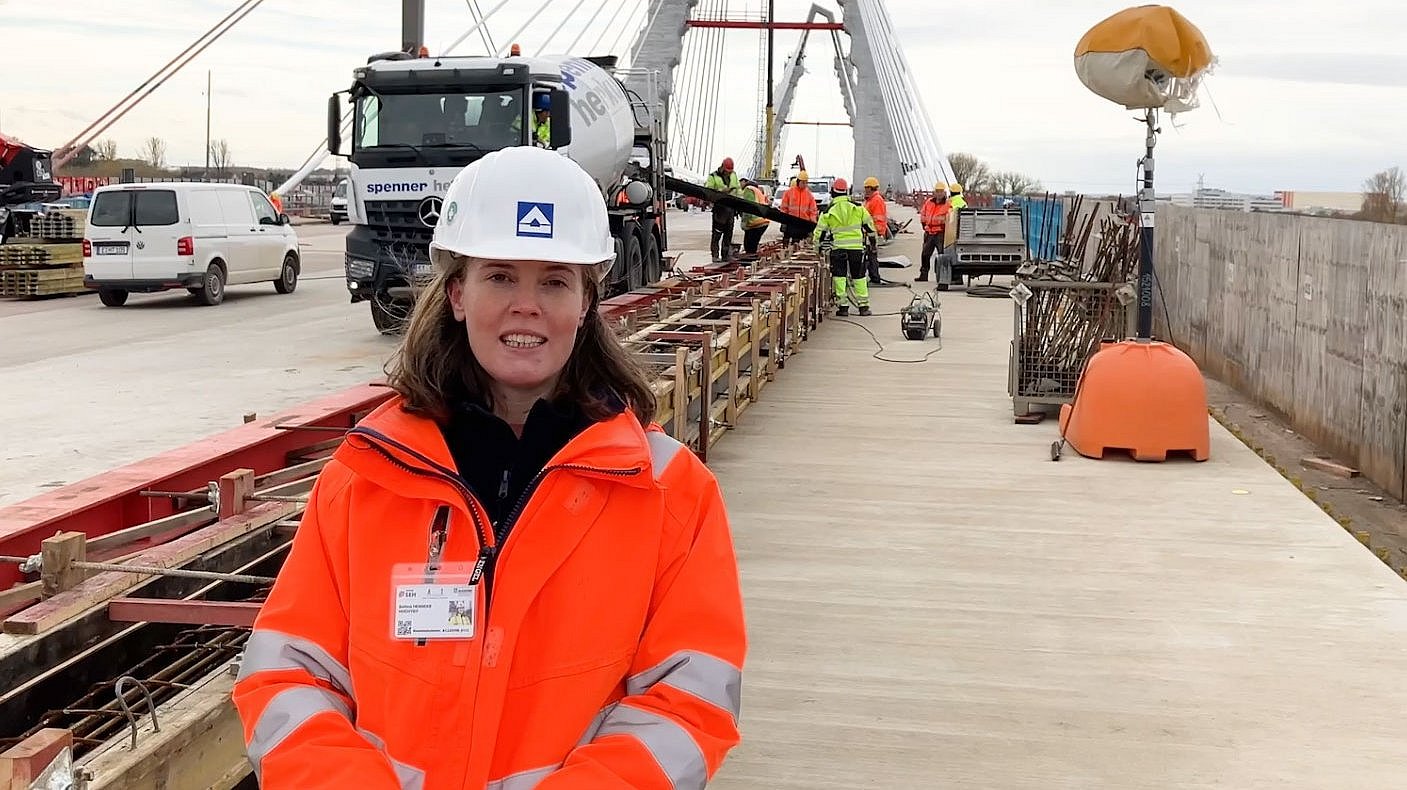
September 5, 2023
Bridge wedding on the A1 near Leverkusen
The first section of the approximately one-kilometer-long new construction of the A1 bridge in Leverkusen reached another milestone today: experts pulled in the last main girders for the bridge closure from a ship. The first bridge structure is scheduled for completion by the end of 2023.
This will resolve the bottleneck of Germany's busiest highways.
From the end of January 2024, car and truck traffic for the Dortmund direction and the Koblenz direction should flow over the new bridge structure.
September 1, 2023
Soon there will be a bridge wedding
On September 5, there will be a wedding. Then symbolically the last bridge part of the A1 bridge will be mounted. Our experts will use a crane to lift the last main girders from the ship. Construction manager Bettina Henneke and 1st site manager Yannis Schwarze explain it like this: "The two main girders will each be lifted up directly from the ship using the red crane construction. The main girders weigh 85 t each and are about 13 m long."
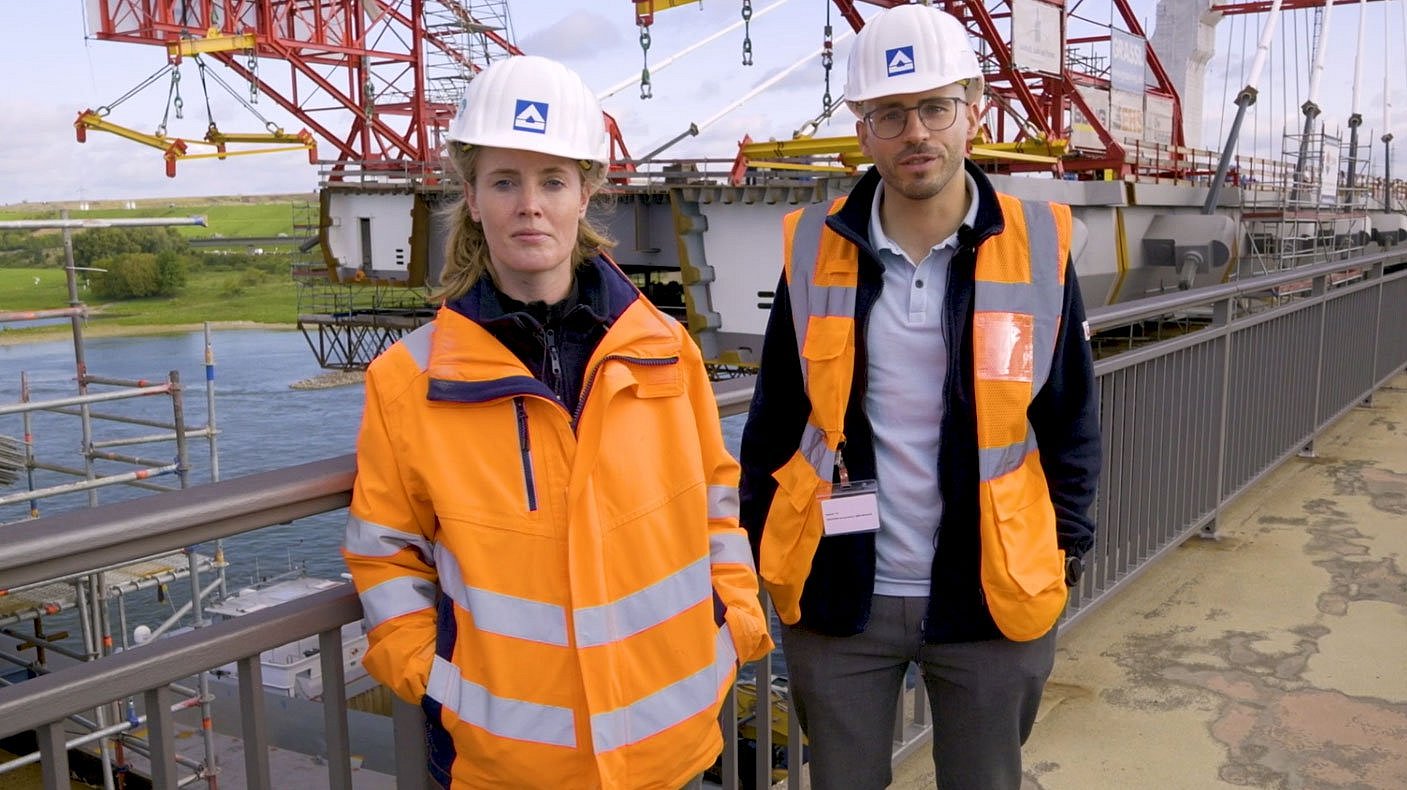
August 7, 2023
On to the second round
On we go! Together with partners, our HOCHTIEF team has been awarded the contract to build the second section of the highway bridge over the Rhine between Cologne and Leverkusen.
Construction of the first section is still in full swing and will be completed by the end of 2023. Traffic will then already be able to flow over the first section. "After that, it's straight on to the second bridge," says project manager Jan Felgendreher (top center) and his team, who are looking forward to managing the major project until it is fully open to traffic.
In the future, cars and trucks will be able to cross the Rhine on four lanes in each direction.
December 8, 2022
Bridge construction by ship
Our HOCHTIEF team is currently assembling the A1 bridge in Leverkusen on the left bank of the Rhine. The start has already been a success: "In cantilever construction, we move the bridge elements into position from the ship and then weld them together," explain construction managers Bettina Henneke and Yannis Schwarze. Experience in the video how this works and what will happen on the right bank of the Rhine in the next few weeks.
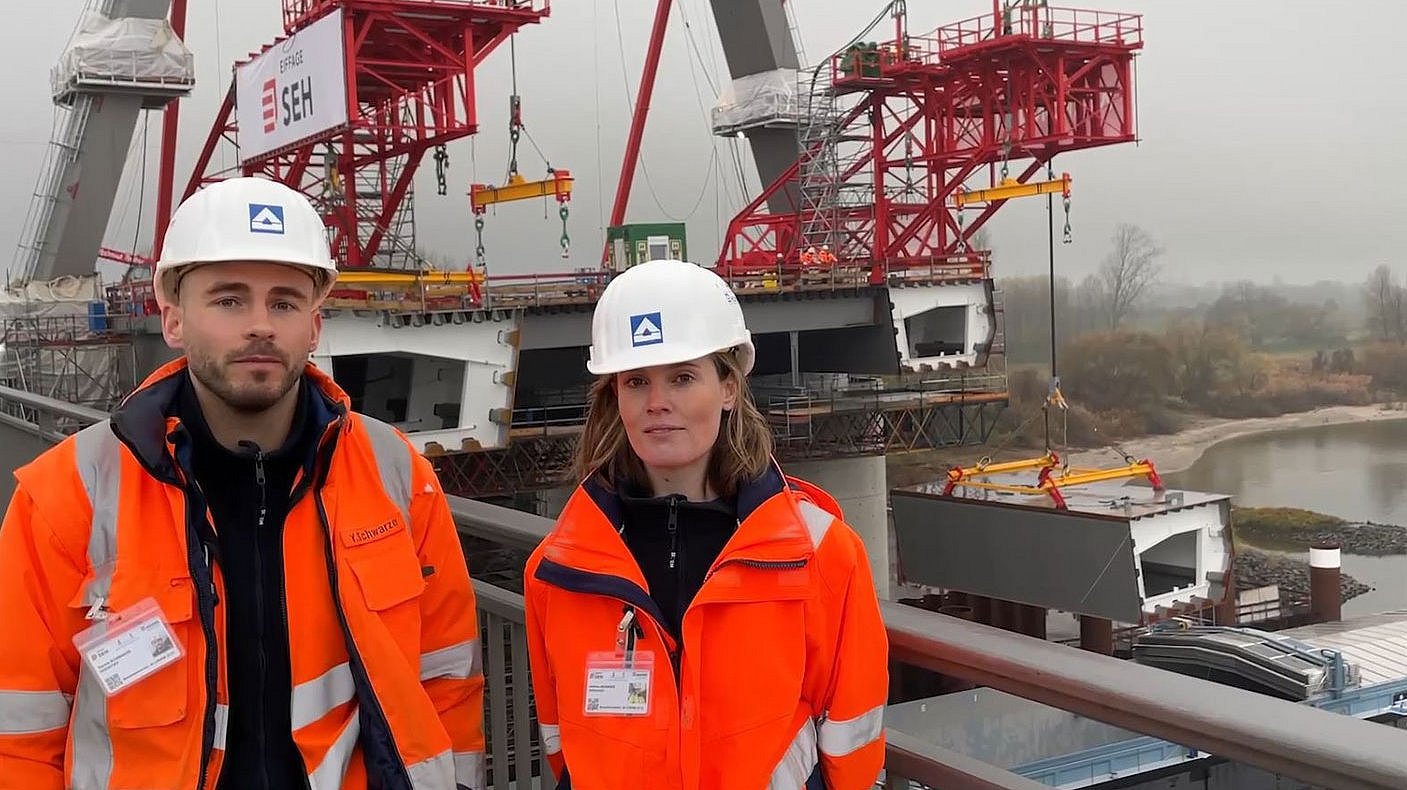
November 14, 2022
Sits, fits. And does not wobble.
HOCHTIEF has reached another milestone in the construction of the A1 Rhine Bridge in Leverkusen. Our team has laid the last of over 700 precast concrete elements. We ensured the high quality of the semifinished parts through close cooperation with our supplier Fuchs, numerous quality controls and the use of digital precast tracking.
Q3 2022
September 14, 2022
Balancing act above the Rhine
The first 1,000-ton pylon for the new Leverkusen Bridge is in place. This week, it will be joined by its twin on the right bank of the Rhine. Site Managers Bettina Henneke and Yannis Schwarze explain what exactly is going on at HOCHTIEF's A1 construction site.
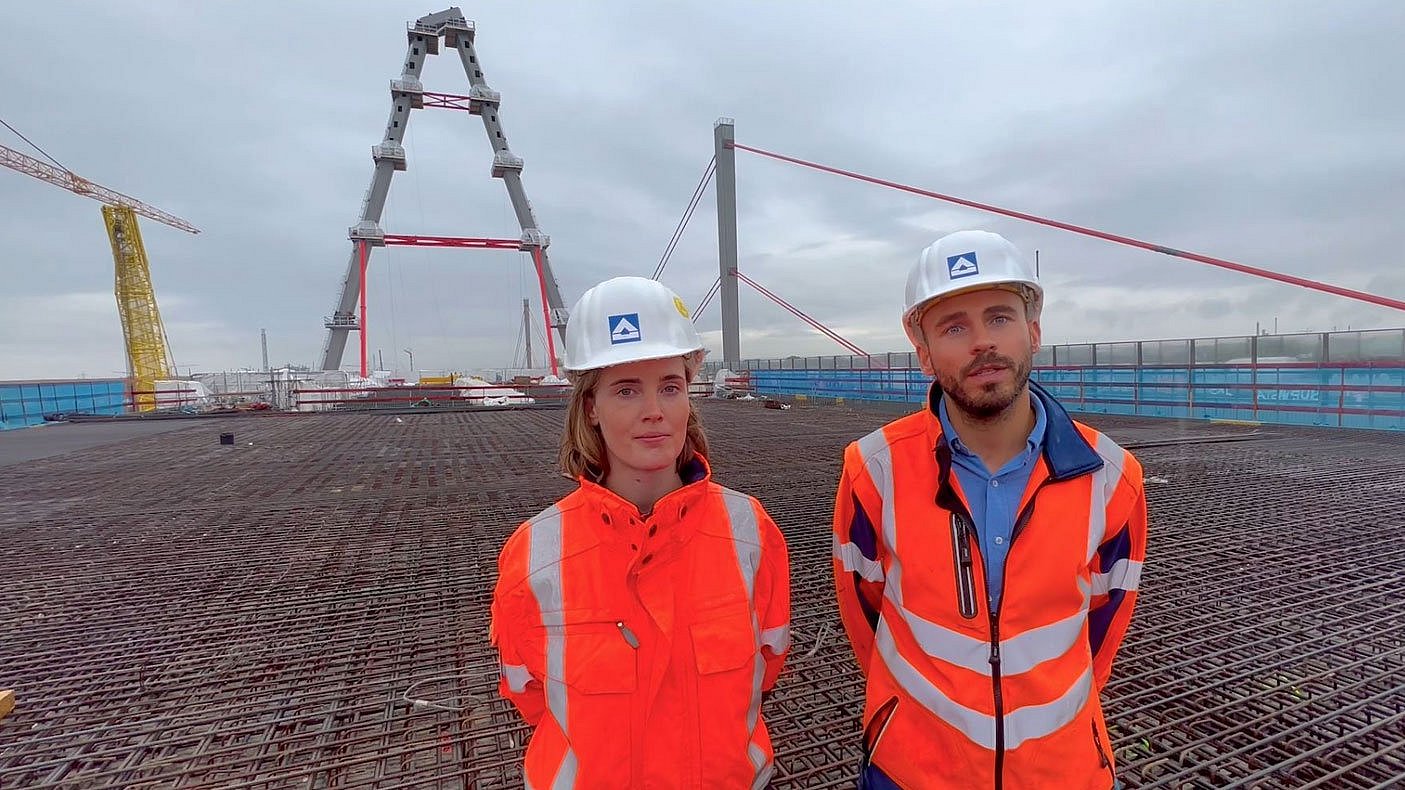
September 12, 2022
August 12, 2022
Top weekend for the A1
"We have to lay a total of 140 precast slabs this weekend," announces site manager Yannis Schwarze (29). "And the installation is taking place in shifts," adds Bettina Henneke (32), also site manager at the A1 bridge construction site in Leverkusen. No less than two truck-mounted cranes are being used to be able to lift the full closure of the A59, which is being bridged at this point, in time for Monday morning. Our entire bridge construction team is working flat out to complete the first of the two new replacement bridges on schedule by the end of 2023.
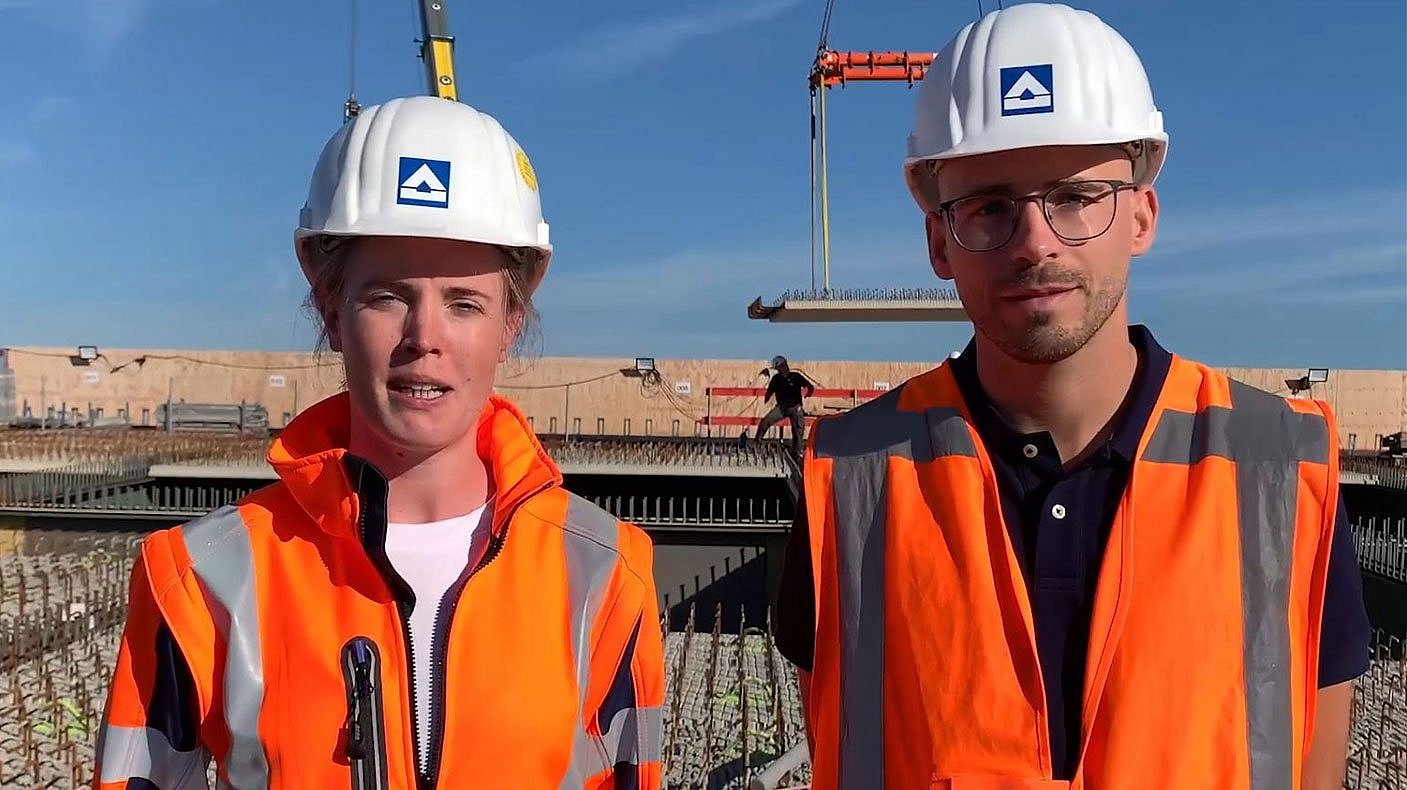
Q2 2022
June 24, 2022
734 slabs with QR codes for the new lifeline
Today we take a closer look behind the scenes at the A1 bridge in Leverkusen, more precisely at the production of the total of 734 precast slabs. "In total, around 1,000 cubic meters of concrete and 360 tons of reinforcing steel are used here," explains Yannis Schwarze (28), site manager at HOCHTIEF. Not an easy task, but we keep our heads above water. HOCHTIEF site manager Bettina Henneke (31) explains how: "To keep these 734 slabs apart, we created QR codes that stored the important properties of each slab. When the precast elements arrive at the construction site, each precast element is first scanned and assigned to a specific storage location." Thanks to this concept, each part only has to be handled once during assembly.
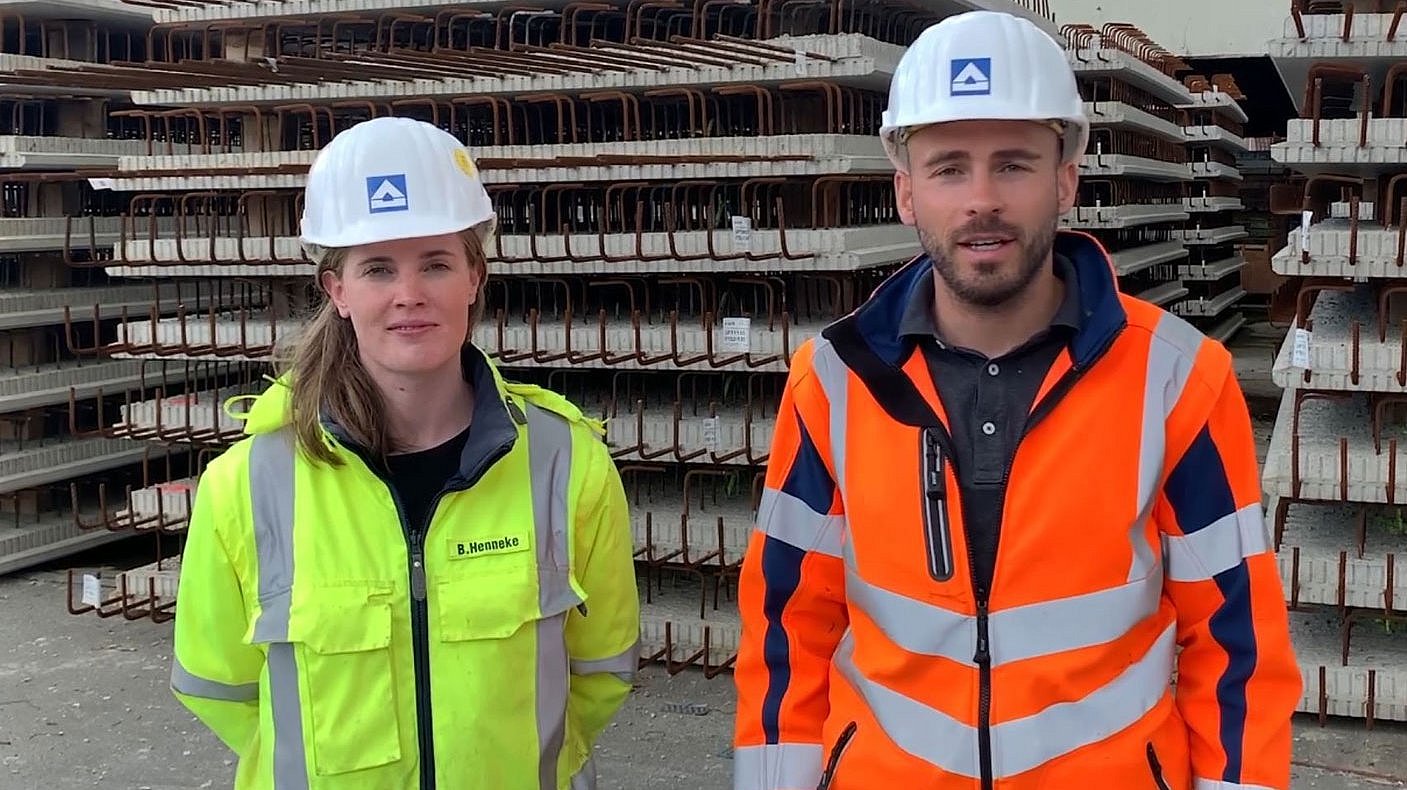
April 26, 2022
Customized steel work for new Rhine bridge
From ship to new A1 bridge: After traveling several 100 kilometers on the Rhine from Strasbourg, two large steel colossi arrived at the Rhine bridge on the A1 near Cologne. Today, the task was to maneuver the giants into the right position: A 700-ton crawler crane was used to hoist the two elements from the ship onto the bridge construction site on the Cologne side. It took a few hours. Now it's done! Another milestone completed on the way to making the northern bypass of Cologne easier for all road users.
April 22, 2022
New steel components for the Rhine bridge
The balancing act over the Rhine continues: "New steel components will be arriving on site by ship next week," says site manager Yannis Schwarze (28), announcing next week's work on the A1 bridge near Leverkusen. "These steel components will be lifted out of the ship by a 700-ton crawler crane and assembled on the Cologne side." Two new bridge sections are scheduled to arrive every day. "To ensure that the steel components are also supported by the subsoil, we have made extensive improvements to the foundation soil," adds site manager Bettina Henneke (32). The main lifeline to the heart of the cathedral city is gradually becoming a modern traffic route. We are working on it continuously.
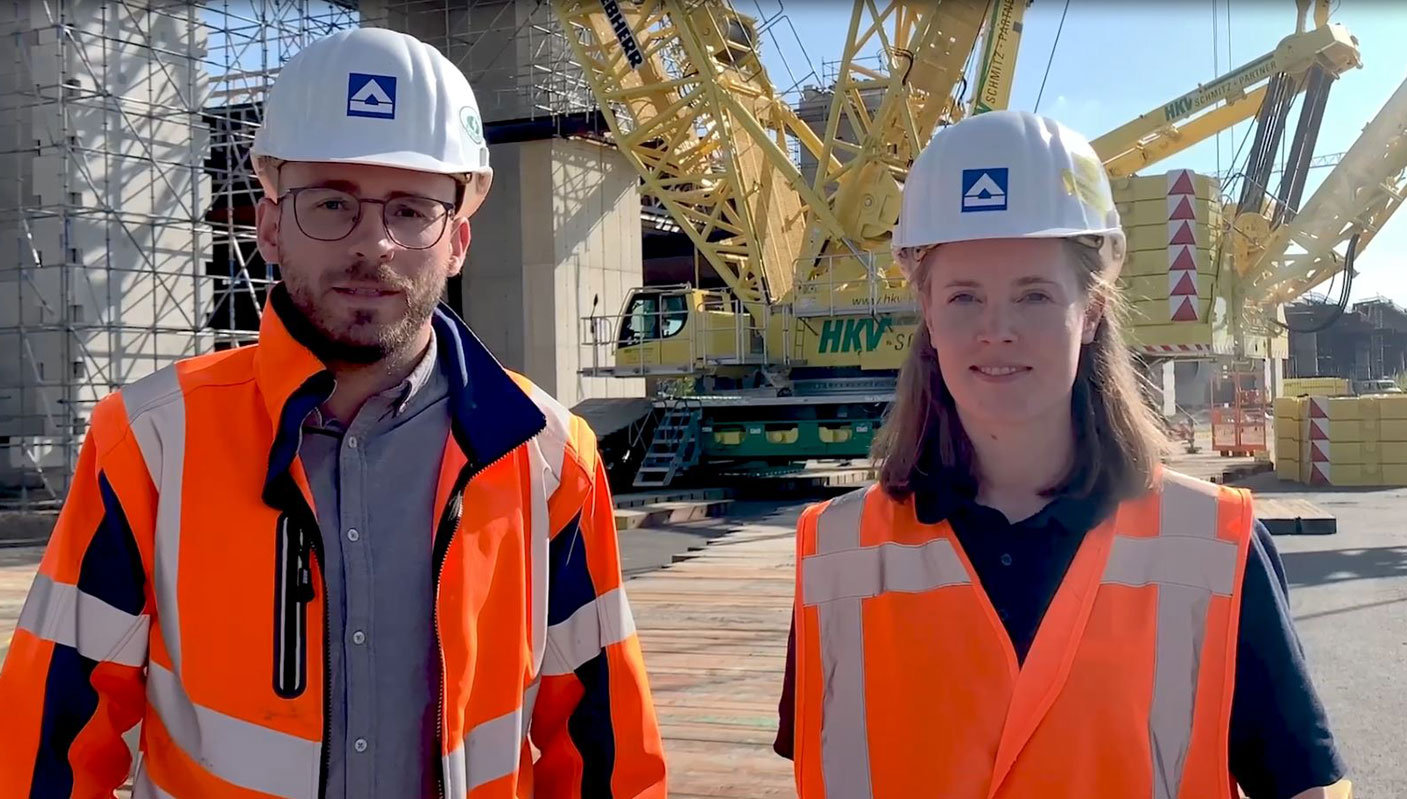
Q1 2022
March 9, 2022
Stacked high
At the HOCHTIEF project on the Leverkusen Bridge, heavy work was done over the weekend—by millipedes. Our joint venture partners from SEH used special equipment to lift the first steel part into the new Rhine bridge. In technical jargon, this is called stacking. And the steel part is a chunk.
It weighs 1,100 tons, is 64 meters long and 34 meters wide. The next chunk on the other side of the Rhine is delivered across the river and lifted in from the water.
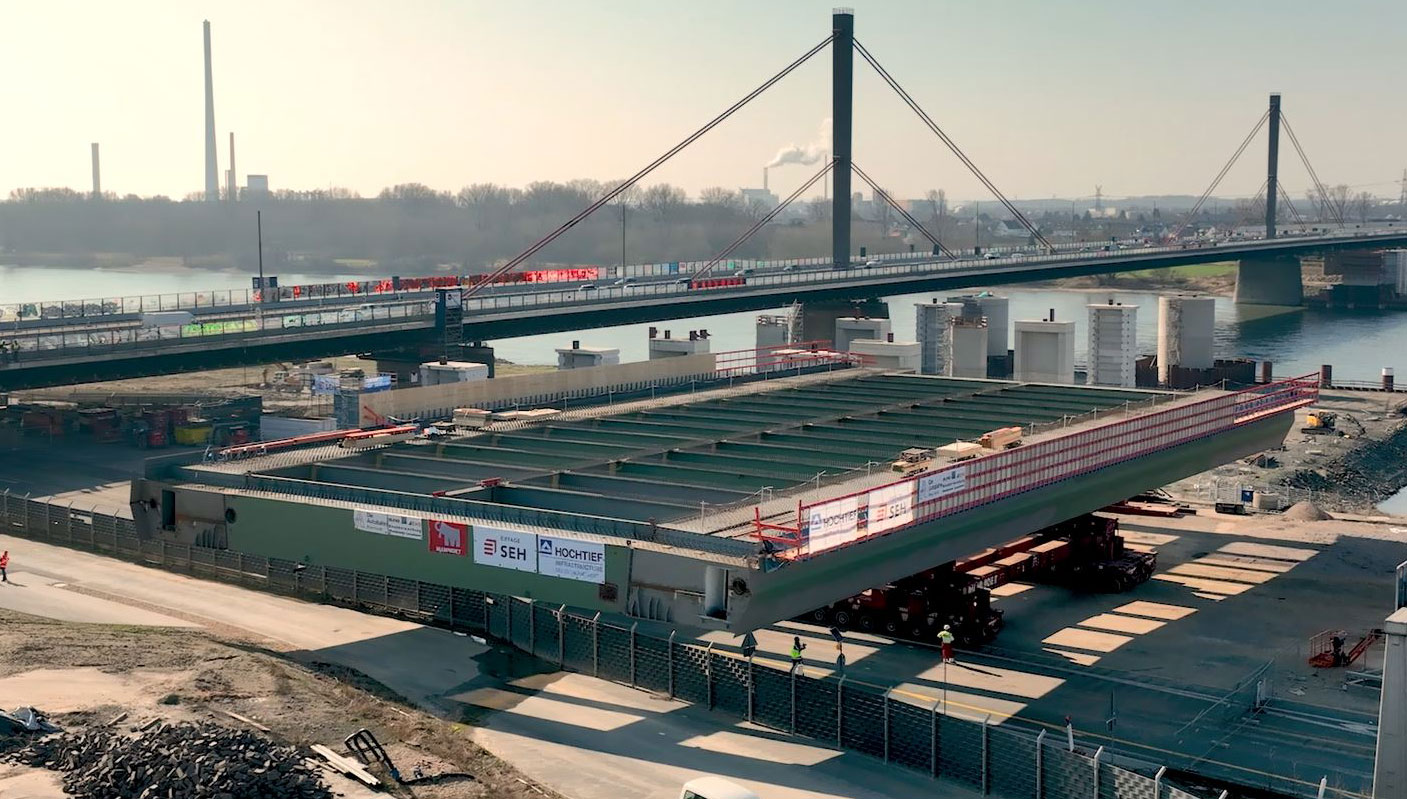
February 10, 2022
450 cubic meters of concrete in eight hours
Trough concreting of the foreshore bridge: this is the part of the Rhine bridge that is still on land. “We are currently pouring the third concreting section and are about to form the carriageway slab,” says HOCHTIEF construction manager Bettina Henneke. "We are pouring 450 cubic meters of concrete right now. That only took eight hours," adds construction manager Yannis Schwarze, "the carriageway slab can even hold a total of 950 cubic meters of concrete."
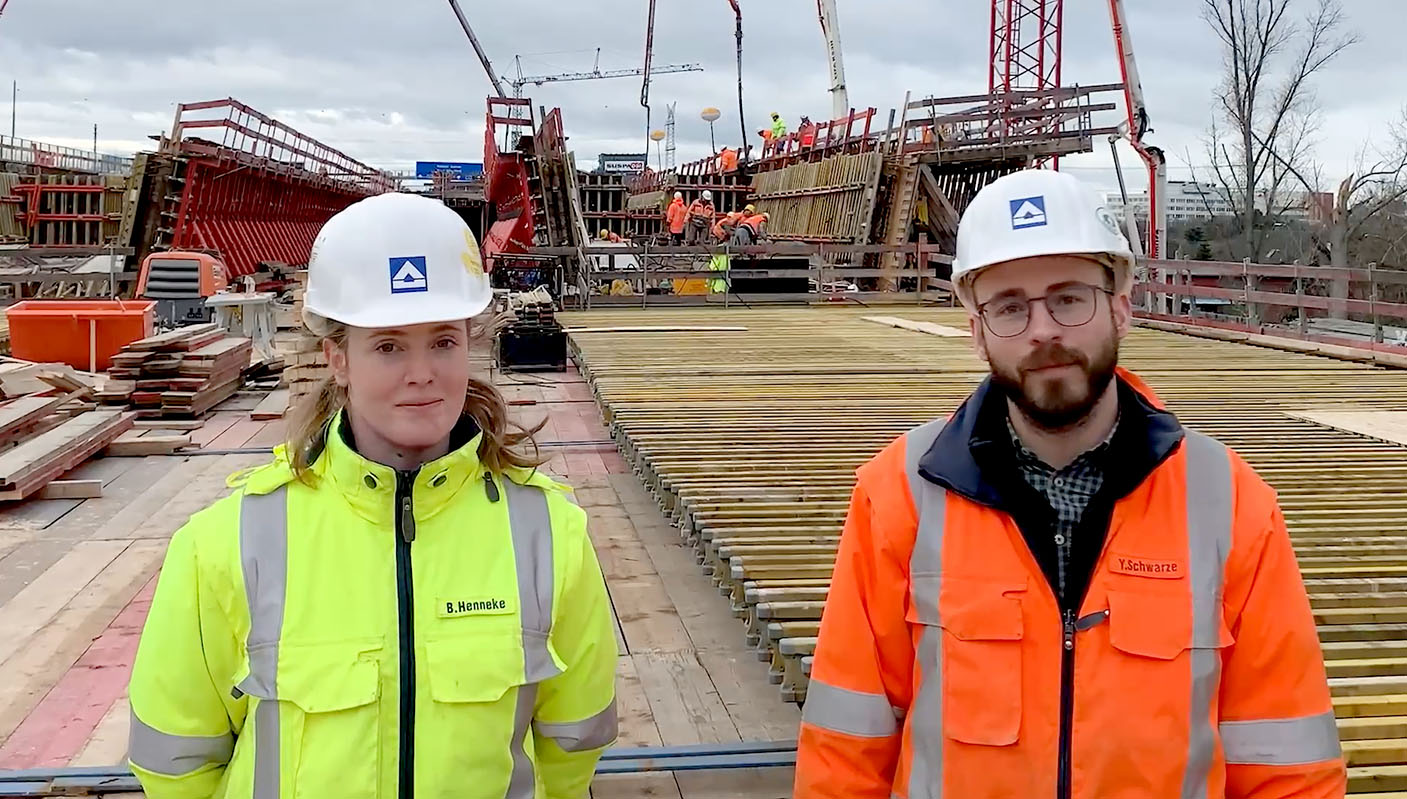
Q4 2021
December 13, 2021
Check
68 meters long, 30 meters wide and half a meter deep on average - the second section of the carriageway slab of the foreshore bridge for the A1 in Leverkusen has been concreted on time. Just under 1,000 cubic meters of concrete arrived on site at precisely the right time. Site manager Bettina Henneke and site supervisor Yannis Schwarze worked with a new software solution from HOCHTIEF's innovation company Nexplore. "From ordering to delivery and inspection to installation, we check and document the concrete for the bridge digitally," explains Schwarze. "This not only increases the quality of the overall work, but also reduces the carbon footprint of concrete processing."
Q3 2021
September 14, 2021
Now it's the steel's turn
Steel is now being used in the construction of the new A1 highway bridge near Leverkusen. The first steel components have arrived. Assembly can begin.
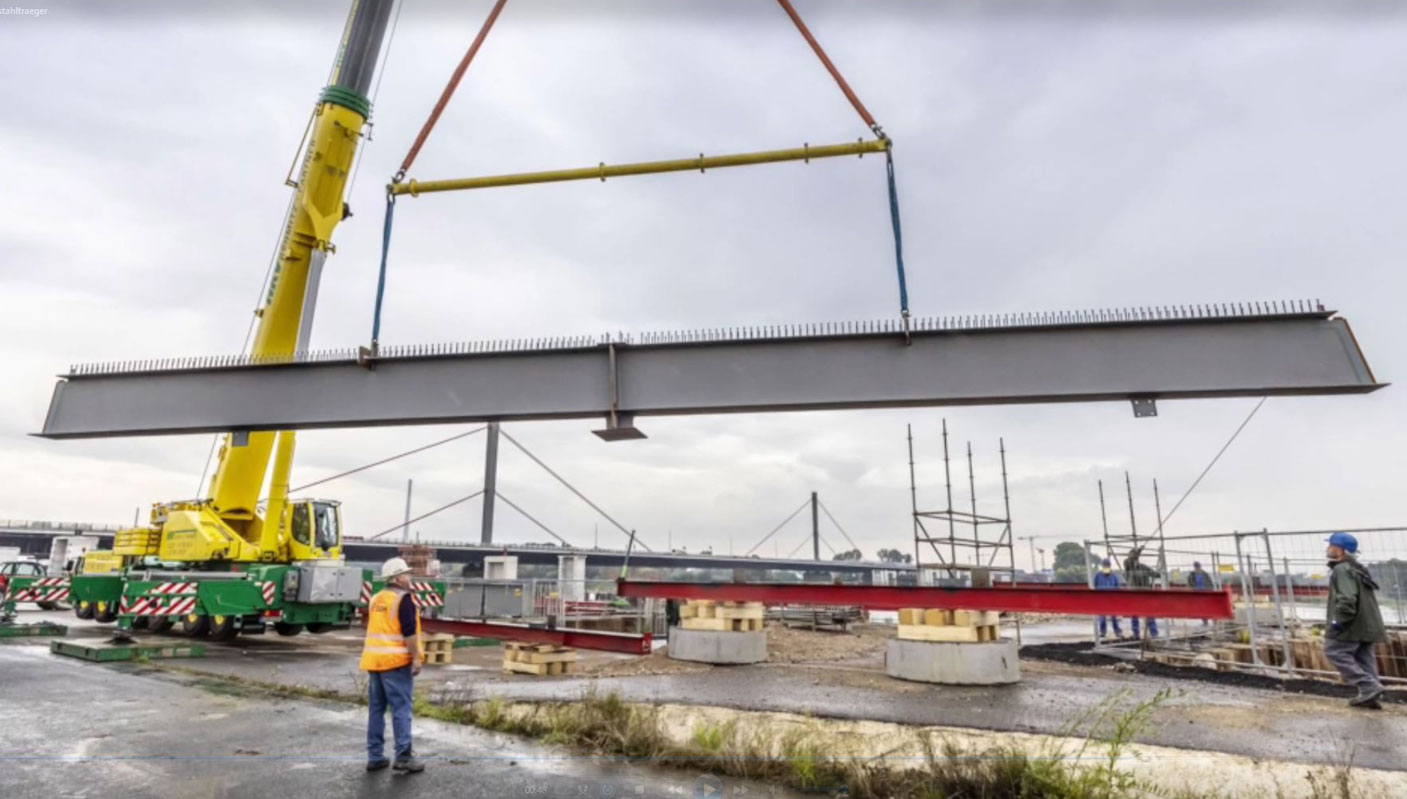
August 30, 2021
Why we put concrete under pressure
Our experts have been building the A1 Rhine Bridge in Leverkusen since the beginning of 2021. Our team is facing the challenge at this traffic junction with concrete expert Renate Schönfeld. She heads one of the three testing stations for the bridge's construction materials: "I check the compressive strength of the concrete. For this purpose, I receive concrete cubes from the construction site. In my more than 20 years at HOCHTIEF, I've put several tens of thousands of cubes under pressure." The concrete has to prove itself in the 47-year-old's laboratory before we lay it.
August 18, 2021
Diver deployment for the new bridge
If you create connections above water, you also have to dive down sometimes. Special divers are currently working on the new A1 highway bridge near Leverkusen to complete preparatory foundation work for one of the two pylons. This week they have been drilling core holes at a depth of around seven meters. In the near future, they will be welding and concreting - all underwater. And only detectable from above detectable by air bubbles.
Juli 9, 2021
One bridge. Two men.
The construction of the new A1 Rhine Bridge in Leverkusen continues. On and on! Formwork and reinforcement work is currently underway on the foreshore bridge, i.e. the part of the Rhine bridge that is still on land. "We want to concrete the foreshore bridge as soon as possible," says HOCHTIEF construction manager Yannis Schwarze. Schwarze is 28 years young. Together with planning coordinator Lars Scheidemantel (34), he is one of the young engineers on the team that has taken over the continued construction of the Rhine Bridge in March 2021. They will keep reporting on progress. Work on the roughly one-kilometer-long structure is scheduled to continue until the end of 2023.
Q2 2021
June 17, 2021
At the bridge, ready, go!
We're giving the A1 Rhine Bridge in Leverkusen a leg up - in concrete. Six meters below the water level of the Rhine, the team led by HOCHTIEF Construction Manager Uwe Schenk today began concreting the first bridge pylon directly on the riverbank.
The construction site is sealed against the ingress of river and groundwater by a sheet pile box. "We are processing 34 cubic meters of concrete per hour and are currently very well on schedule," says Uwe Schenk. "Later in the day, we want to reach the pylon's full height of 5.30 meters and have used 300 cubic meters of concrete."
Q1 2021
March 25, 2021
Get ready to drill
We are spitting in our hands to start work on the A1 Rhine Bridge in Leverkusen. After HOCHTIEF was awarded the contract to continue construction in February, the Maxi drilling machine arrived yesterday. "We'll assemble it today and tomorrow we can get started," says Kieran Engesser (33), site manager for special civil engineering at HOCHTIEF. The drilling rig is quite something. Our experts are using it to drill almost 34 meters deep into the earth at 24 locations so that they can then install concrete piles for the bridge pylons. The boreholes are also of extreme size, with a diameter of 1.50 meters. Work on the approximately one-kilometer-long structure is scheduled to continue until the end of 2023.
The plan
The Rhine Bridge, opened in 1965, was designed for 40,000 vehicles per day. A good 50 years later, the reality is different: Around three times as many cars and trucks were traveling here until the first traffic restrictions. Above all, the 14,000 trucks per day took their toll on the structure, acting as an accelerator of the aging process. Due to the increase in traffic, the Kölner Ring was widened to six lanes by 1995. The new Rhine Bridge replacement consists of two individual, parallel bridge superstructures. HOCHTIEF is currently building the first part of the new structure to the north, directly adjacent to the current bridge. After completion, all traffic will initially flow over this new structure. The old Rhine bridge will then be demolished before the second bridge is built on the same site. In this way, the flow of traffic will be ensured during the entire construction period. When the new Rhine bridge is completely finished, traffic will be able to flow over eight lanes. Furthermore, the bridge entrances and exits on both sides of the Rhine will have two lanes. This will result in a higher number of lanes at these interchanges, with a maximum of twelve. In addition, there will be a 3.25-meter-wide bicycle and pedestrian path on both sides.
